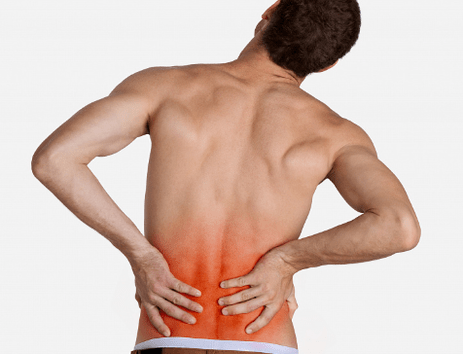Lumbar osteochondrosis is a deformation of the spine in the lumbar region.The disease affects intervertebral discs, cartilage tissues, spinal roots and nerve fibers and causes back pain.
Reasons

The main cause of the disease is the improper distribution of the load on the musculoskeletal system.Usually this happens when you walk to high heels, they wear a bag on one side, with an uncomfortable pose in a dream or in a seated job.At risk are elderly, pregnant people, only professional athletes and employees.
Other causes of lumbar osteochondrosis:
- lesions, bruises, fractures of arms, legs, spine;
- damage to the organs of the musculoskeletal system;
- gastrointestinal diseases that cause a deficiency of beneficial substances;
- Body tension with prolonged loads;
- Psychoemotion disorders;
- violations of the blood flow in the spine;
- Inflammation of the musculoskeletal system;
- internal organs and vertebrae infections;
- stiffness of the joints, shift of the discs;
- Protrusion and intervertebral hernias;
- serious intoxication;
- metabolic disorders;
- curvature of the posture;
- sedentary lifestyle;
- dehydration;
- unbalanced diet;
- Deficiency of calcium and oxygen;
- Excess weight;
- bad habits;
- age -related changes;
- joint diseases.
Symptoms of lumbar osteochondosis
The intensity and nature of the symptoms depend on the stage of the disease.The patient faster finds signs of lumbosacral osteochondrosis, the treatment will be more effective.
General symptoms:
- severe pain on the bottom of the rear, which can give the foot and the internal organs of the abdomen and the pelvis;
- pain in the kidney and sacred;
- fatigue and stress in the lower back and in the sacral section of the spine;
- Difficulty moving, walking, inclinations and body curves;
- Periodic background in the rear;
- fatigue after minor load;
- Crunch in the back, violation of mobility, pain in a calm state;
- numbness of the limbs;
- Spasms and cramps in the muscles;
- dizziness;
- weakness and loss of strength;
- Reduce muscle tone and sensitivity.
In men and women, manifestations of lumbar osteochondrosis may vary.Men can have problems with power.Women often suffer from pelvis pain.When a deformed spine cannot completely support the back, uterus and appendages experience additional loads and sometimes move around a normal physiological position.
Variety
The classification of the osteocondrosis of the lumbar column is made up of different varieties of the disease.With the type of pain syndrome, they distinguish:
Lumbago.Acute symptom.It is expressed by sharp bastards and the inability to move.It occurs with muscle cramps, injuries, pinches of discs and nerve roots.
Lumagly.It is characterized by long -term painful pain caused by hernias, protrusions, spondylartrio, ligaments and other ailments of the musculoskeletal system.
Sciatica.Powerful pain syndrome in the lumbosacral department, Eradiri in the pelvis.The pain applies to the sciatic nerve, prevents the normal flexion and extension of the body, prevents me from sitting and painlessly standing.
Discogenic lumbar osteochondosis and radicolopathy are also distinguished.
Discogenic lumbar osteochondosisIt is accompanied by a loss of sensitivity and numbness not only of the painful back, but also of the legs, the buttocks, the hips and the bottom of the abdomen.Sometimes body temperature, weakness, urinary incontinence increases, the patient loses weight.
Radicolopathyexpressed by the intorpidement of the nerve roots and a decrease in human motor skills.Signs: tingling or pain of the entire lower body, compromised reflections, decrease in muscle tone and articles of the limbs.
Phase of development of lumbar osteochondosis
Doctors trace the dynamics of the pathology in four phases:
- First.The symptoms are almost invisible: they are diagnosed in an X -ray. The stage begins with pathological processes in the intentional cavity of the overcoming of the disc and the microcack of the fibrous ring.
- Second.The height of the intervertebral discs is reduced, which makes the vertebrae closely.This causes the sliding and movement of the vertebrae, which is accompanied by pain during movements.
- Third.It is characterized by rigidity, instability, numbness of the body in the coccyx, in the lower part of the back and sacred.This can be explained by the protruding vertebrae, propusions, joint dislocations and arthrosis in the spine.
- Fourth.The most serious degree.The functions of the spine are compromised on it and bone growth (osteophytes) are formed.Growals can pinch the nerves or damage the integrity of the vertebrae.
The consequences of the osteochondosis of the lumbar
- Excessive accumulation of salt in the body;
- development of hernia, protrusion, prolapse of the vertebrae and discs;
- chronic roots;
- Parents and paralysis of the legs.
Diagnostics
Lumbar osteochondrosis and other musculoskeletal system disorders can diagnose orthopedists, osteopath, neurologist, rheumatologist, manual and surgeon therapist.It is possible to make an accurate diagnosis after:
- X -Rays of the spinal column, which shows the condition of bones of bones, cartilage and muscles, as well as ligaments and tendons.
- Myelography - studies on cerebrospinal liquid with dye.With its help, the nerve roots of the spinal cord are studied and evaluated.
For a more detailed examination, doctors use CT and MRI.You can undergo diagnostics in the clinic.


























